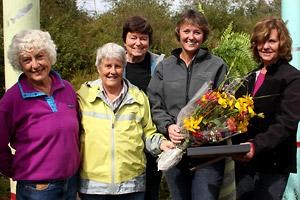by Laura Walz [email protected] A non-profit society has recognized the contribution of a Powell River energy company in finding a solution for protecting salmon habitat.
Members of Myrtle Creek Stewards Society presented Debbi Stanyer, water resource and environment manager with Brookfield Renewable Power, with a plaque and flowers for her work in the project.
The company owns an access road, between Claridge Road and Myrtle Avenue, that crosses Myrtle Creek. The creek supports both wild chum and coho salmon, as well as other fish populations. Valuable marine pools for juvenile coho are located just above the area where the access road crosses the creek.
A rock barricade didn’t stop either truck drivers or ATV operators from driving through the creek at this location. The access road slopes downward to the creek, which allows truckloads of silt over the years to flow into the water. This silt eventually covers the floor of the entire creek, destroying salmon habitat.
Esther Dyck, president of the society, contacted Stanyer over a year ago to solicit her support in finding a solution.
“It was apparent that this road was getting pretty beat up with other traffic on the road,” said Stanyer. “It was causing siltation into the creek.”
While the company owns the access road, Stanyer added, which is located under the transmission line, “it’s not an area that we need to access by vehicle. We would if we have any issues with the line, but when we do any brushing in here, we walk.”
After Dyck talked to Stanyer about the issue, Brookfield had one of its contractors, who does work for the company on its roads, look into ways to minimize the siltation. “One of the things that we thought of was to put in something that would stop the traffic from going over, therefore they wouldn’t be coming down the road,” Stanyer said.
There were numerous meetings over a year to find a solution, discussions that included BCTC (BC Transmission Corporation) because it has an interest in the area.
A first attempt at a barrier didn’t last because someone cut through steel bars. Then the proponents came up with the idea of using concrete pillars which can’t be moved or cut down.
The spacing allows horses to pass through as well as hikers and runners. “We tried to exclude the four-wheel vehicle traffic, but let everyone else go through,” said Stanyer. “I think it’s a solution that is going to work. It’s not intrusive. Now that the pillars are painted, they blend in quite nicely. People can still get in and out of here and use the area.”
Dyck said she appreciates all the work and time that Stanyer spent with her on the project. “A couple of fellows from BC Transmission were very good as well,” she said. “It’s huge for the creek. This area was always a big headache. Now that it’s beautified, I think people that maybe didn’t care as much before will have a second look. They see that it’s important.”
The society is not the only community group pleased with the solution. Alston Miller, representing Sunshine Coast Athletics, a running group whose members participate in ultra-marathons and road races, also presented Stanyer with a plaque that recognized her contribution.
Miller said the pillars help to keep a natural feel to the area. “There’s less mud and disruption,” he said. “We were having problems before with trucks getting stuck in here, with people four-by-fouring and illegal dumping of garbage. I’ve seen a decrease in those types of activities since the pillars have gone in.”
The society plans to install educational signs as well to raise awareness about the importance of the creek and this particular crossing.



